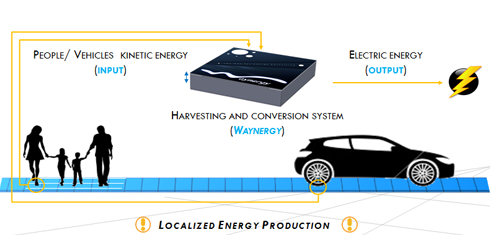Generation of electricity by the movement of people and vehicles on a designed pavement surface
Waydip is a start-up firm based in Portugal which is engaged in technological research and development to improve energy efficiency in transport. The company has developed a system that can be implemented on pavements to capture the kinetic energy produced by people and vehicle movement, and transform it into electrical energy.

The challenge
Energy generation that relies less on fossil fuels and causes less pollution is one of the key challenges of our economy. Cities in particular are high consumers of energy both in cumulative and per capita terms.
Waydip pavement tiles and floors provide a possible solution for integrating energy production in urban areas; conserving and converting the kinetic energy produced by humans and the movement of vehicles, into electric energy in frequented urban places such as shopping centres, hospitals, schools and public parks etc. This innovative surface offers an opportunity for integrating conserved electricity into batteries and the electricity grid, which can then be consumed by electrical equipment and instruments.
The innovation
Waynergy People and Waynergy Vehicles (special tiles/floor-plates which respectively produce energy from people’s and vehicles’ movement) can be used to generate power.
The determining factor for the generation of energy is the weight exerted on the Waynergy equipped floor. The heavier the element that passes over the floor, the more power is generated. Each plate or tile system has incorporated small motors, which produce energy when pressed and store this energy in batteries which can be used in real-time or at a later stage.
Why did it work?
Waynergy products resulted from internal R&D at a private company, WayDip, in collaboration with the Pavement Mechanics Laboratory of the University of Coimbra. WayDip raised venture capital for development, demonstration and commercial exploitation by winning the ISCTE-IUL MIT Portugal Venture Completion and EDP Richard Branson Innovation Award.
All prototypes developed were put to test for validation. They performed successfully during laboratory and some preliminary real environment tests. One real-environment test of the system was conducted at Pero da Covilhã Hospital in May 2013 where ‘Wayenergy People’ were installed on treadmills and along a walkway to produce energy from the movement of people and to power a luminous information panel.
The company also carried out a real-life environment test of ‘Wayenergy Vehicles’ in Covilhã. The system was installed to produce energy with the passage and braking of vehicles. This energy was used for the power supply of lights.
Further deployment
More real-time experiments are planned in the future which will allow one to monitor the behaviour of the system, analysing the amount of energy produced and the resulting CO2 savings, and allowing further adjustments to be made to the technology. As the company is currently in the preparation stage for commercial exploitation it is assumed that the technology is a 7 on TRL scale.
Links;
The website